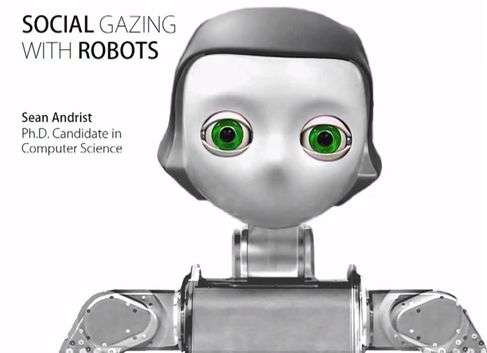February 2, 2016 weblog
Robot-human eye contact helps conversation flow

Pop music is littered with titles that relay how romantic yearning is sparked and experienced wordlessly with one person staring at the other. Animals don't have it so good. "Most mammals generally interpret direct gaze as threatening or as a sign of dominance," wrote researchers in Frontiers In Human Neuroscience.
People, however, usually take gazing with positive interpretations, such as affection, love and attraction. "A preference for direct gaze seems to be present at a very early age: Farroni et al. (2002) found that infants as young as 2 days old prefer to look at faces that gazed directly at them compared to faces with averted gaze."
If social gazing goes down so well between humans, what about between robot and human? Sean Andrist, doctoral candidate in computer science, UW-Madison Graduate School, has seriously explored that question.
Andrist is reminded of the expression of eyes as windows to the soul. We don't just use our eyes to see, but to communicate, unconsciously and consciously; that is how we nonverbally read signals from each, helping along communication.
Andrist has set out to determine if, when we give robots eyes and enable them to use those eyes, will conversations between humans and robots go more smoothly?
If the answer is yes, then it would be possible, for example, for a robot to get you to exercise more, or put together an assembly-required table, or behave as an assistant for the elderly, helping the person to take medication or stay active.
Evan Ackerman in IEEE Spectrum talked about the robots targeted to motivate: "For things like social and physical assistance, it's going to be critical for robots to use every tool at their disposal to encourage humans to complete tasks that may be boring or repetitive."
Andrist has developed models of social gaze behavior for humanoid robots. He studied the way humans look at each other in a motivational setting. He then turned that understanding into an algorithm which he could implement on a robot platform. He has also evaluated the robot's use of that gaze behavior, to see if it actually improves interactions with real people.
In the process of making robot gazing work, it would be necessary also to take into account that people positively perceive good intentions when the other person is doing just that, gazing rather than staring.
"I was interested in when do people look away from other people so that we are not just staring at each other all the time?" he said. After all, without any intervention, robots could be staring at you all day and that's not good. Looking away once in a while is actually important.
He asked people into the lab and just had them have a conversation with one another. He measured precisely when and how they were looking away from each other.
He invited new people to come in, and to have conversations with the robot. He observed that these conversations were much more fluid when the robot looked away correctly; there were less interruptions and generally more enjoyment in the conversations.
In the bigger picture, research paths such as this confirm the great potential of robotics in fields beyond defense and first-responder assistance in the wake of diasters. Assistive roles by robots could be played out for the sick, elderly, young children and learners of all ages. First things first, however; robot designers and engineers must figure out ways to make humanoid robots genuinely non-threatening in appearance and assistive in behavior.
What's next for Andrist and his research team? Ackerman said, "In the future, they're planning to increase the granularity and sophistication of these gaze models, as well as testing on more targeted populations who are likely to benefit most from robotic assistance."
© 2016 Tech Xplore



















